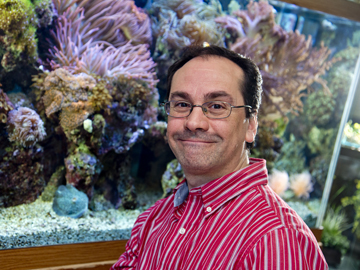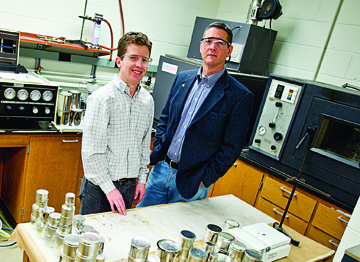Purdue civil engineers increasingly look to nature to improve material performance
April 4, 2013
 |
|
Pablo
Zavattieri, assistant professor of civil engineering with a courtesy
appointment in mechanical engineering, has studied how the nacreous layer of
abalone shells gain toughness without sacrificing strength or stiffness. He
recently received a National Science Foundation Career award to explore some of
the bold and innovative ideas on biomimetics. (Purdue University photo/Mark
Simons)
|
Inventors and innovators have long looked to nature for inspiration. Thomas Edison likely marveled at a summer evening's fireflies before the light bulb went off in his head. Surely the Wright brothers looked to flying birds in Kitty Hawk before their first manned flight.
Perhaps the most famous case of bio-inspired engineering comes from Georges de Mestral, the Swiss engineer who invented Velcro. In 1941, on return from a hunting trip with his dog in the Alps, Mestral examined the burrs, or seeds from burdock, stuck both to his coat and his dog's fur. Fast forward 15 years and those same hooks and loops he discovered under the microscope would be mimicked and patented to give zippers and shoestrings a run for the money in the marketplace.
It's not uncommon for civil engineers today, often pushing the boundaries of their own expertise, to look to nature for a better design. Two among Purdue's ranks include John Haddock, associate professor of civil engineering and director of the Indiana Local Technical Assistance Program (IN-LTAP), and Pablo Zavattieri, assistant professor of civil engineering with a courtesy appointment in mechanical engineering.
 |
|
John
Haddock (right) is exploring soy-based binders for improved road construction. (Purdue
University photo/Mark Simons)
|
Haddock is on a material search that could lead to better roads and surface pavement, consequently saving energy along the way. For his part, Zavattieri is looking to create stronger structural materials. Both researchers are mining nature's secrets for infrastructure solutions in civil engineering.
Adaptive engineering
Natural products are used quite often in producing asphalt binder, says Haddock, who started looking into soy-based binders in 2009. The binder is refined from crude oil, a natural product itself.
Haddock continues on the road to produce better asphalt, in turn leading to energy savings, a critical challenge in road con- struction and maintenance. "Not only is asphalt binder refined from crude oil," he says, "but it also takes energy to produce as- phalt mixtures and place them on the road."
Haddock says energy savings are achieved when new additives can help roads last longer. One breakthrough is the use of warm-mix asphalt over hot-mix asphalt, which saves energy by reducing production temperatures, thus saving fuel. Similarly, the use of recycled products like reclaimed asphalt pavement and reclaimed asphalt shingles is on the rise.
Zavattieri had long been interested in nature's potential solutions to engineering problems, but he first brought his curiosity to his research about eight years ago. He began studying how shells, specifically the nacreous layer of abalone shells, gain their toughness without sacrificing strength or stiffness.
The long-term goal, Zavattieri says, is for his research group to understand how nature employs these strategies to further the knowledge necessary to design cost-effective and environmentally friendly multifunctional materials. The researchers focus on elucidating the microstructure and mechanisms behind the mechanical performances with an end goal of duplicating them in artificial materials.
"Materials in nature not only satisfy a structural function in many remarkable ways, but they also do more," Zavattieri says. "Materials can also sense, adapt and self-heal."
Zavattieri points to a biomimetic building in Zimbabwe that has no air conditioning, but stays cool through a termite-inspired ventilation system. "Architects are perhaps ahead of engineers in terms of ideas borrowed from nature as they are already thinking about green and sustainable solutions for heating and cooling by imagining special skins for buildings that can breathe, control light and exchange energy with the environment on demand," he says.
Still, the interdisciplinary nature of the research is sure to push the results. For Zavattieri, an atypical civil engineer who earned a bachelor's degree in nuclear engineering, obtained a PhD in aeronautics and astronautics and worked in the automotive industry for nine years, the research quest has never been about boundaries. "I continue to learn how to communicate with, and learn from, biologists, material scientists, chemists, physicists and other engineers working on other aspects of structural challenges," he says.
Natural intelligence
"I don't believe the materials we are seeing nowadays for our infrastructure will look the same 20 years from now," Zavattieri says. "In fact, I think materials will have more functionality than just satisfying the structural purposes such as columns, beams and walls."
Zavattieri believes a bio-inspired push will continue to allow engineering materials to do more. Laptop or phone batteries could be designed as part of a protective case that is not only strong but also has great energy absorption capabilities to protect the electronics, he says. Walls and structural components of bridges, roads and buildings could also sense and adapt to environmental forces. Perhaps to save energy, but also to self-heal quickly in times of natural disasters.
"Imagine a structure in danger of collapsing after an earthquake," Zavattieri explains. "Intelligent materials and structures can sense damage and either adapt so that the load path of the structure changes, or self-heals, so lives can be saved. In those cases, only a few hours of structural integrity are needed until emergency responders can rescue people."
The very call to biomimicry seems to know few boundaries of possibility. Zavattieri points to solar cells inspired by plant leaves; high-strength fibers spawned from spider silk (one of the strongest materials known); multifrequency radars indebted to bats; smart materials fitted from dolphin skins or sea cucumbers; camouflage and morphing skins from squid, octopus and the like; fuel-economy flying devices linked to hummingbirds; and on and on.
Research restructured
Haddock's investigations into the soybean refining process that lead to soy-based products has not made him an expert in a new field, he says, but he's had to learn more about organic chemistry.
In his IN-LTAP role, Haddock can see how smarter approaches to improved roads can have rippling effects throughout local economies. Research, he says, indicates that smoother roads contribute to better vehicle fuel economy. Better-built roads require less reconstruction and overhaul. And energy savings from the asphalt bindings lighten the load of petroleum use.
Emerging technologies, such as microfabrication and nanotechnology, will further the development of biomimetic material designs. Fortunately, many of the cutting-edge facilities in Purdue's Discovery Park are providing interdisciplinary homes for such research. As the College of Engineering pushes forward on an unprecedented hiring campaign, these ever-curious faculty researchers and their students should find an inviting home at Purdue.
"As part of their training, this new generation of researchers will have to be exposed to a wide variety of state-of-the-art experimental equipment and computational techniques while becoming immersed in a true collaborative and multidisciplinary setting," Zavattieri says.
As such, Zavattieri always suggests that students embrace that training by taking courses not just within engineering, but also throughout the sciences at Purdue. "I also tell students to always be on the lookout for solutions in nature. You never know if the solution lies right in front of you."
The openness to collaboration, to take part in diverse teams working toward grand solutions, can put any young researcher on a creative course for great discoveries. Haddock encourages his students to maintain integrity in everything they do. "Beyond that," he says, "success is mostly a result of hard work."
Writer: William Meiners, 49-66524, wmeiners@purdue.edu
